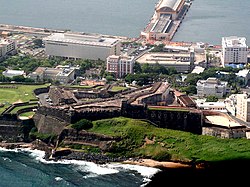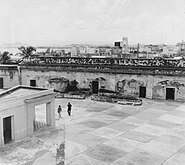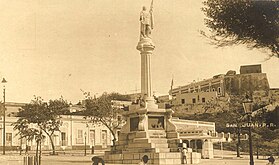|
Castillo San Cristóbal (San Juan)
Castillo San Cristóbal (English: Saint Christopher Castle) is a fortress in the historic district of Old San Juan, Puerto Rico, known as the largest fortification built by the Spanish in the New World.[2] Dating back to defense expansions following attacks by the English in 1598 and the Dutch in 1625, it was first built in 1634 as the Garita del Diablo ("devil’s sentry box") and an artillery platform.[3] Over the next 150 years, especially in the reign of King Charles III of Spain, it continued to be developed into a bastion fort to reach its largest size in 1790.[4] Rising 150 ft from the Atlantic shoreline, the three-level edifice stands on a hill at the northern coastline of San Juan Islet, guarding the land entry to Old San Juan.[5] San Cristóbal, alongside El Morro, La Fortaleza, and other forts part of the Walls of Old San Juan, protected strategically and militarily important Puerto Rico, or La Llave de las Indias (The Key to the Indies),[6] from invasion by competing world powers during the Age of Sail. It was designated a World Heritage Site by UNESCO in 1983.[7]  History Castillo San Cristóbal was built on a hill originally known as the Cerro de la Horca ("gallows Hill") or the Cerro del Quemadero ("burner’s hill"), changed to Cerro de San Cristóbal in honor of Saint Christopher, the patron of travelers. The fortress is considered the largest fortification built by Spain in the New World. When it was completed in 1783, it covered about 27 acres. The entrances to it were protected by two gates and drawbridges in what was called the Revellín de Santiago (Saint James Ravelin) and the Bastión de Santiago (Saint James Bastion). After close to a hundred years of relative peace in the area, this section of the fortification (about a third) was demolished in 1897 to help ease the flow of traffic in and out of the walled city.  In 1634, the first defensive structure had been built in the area, the Fortín del Espigón ("breakwater fort")or the Garita del Diablo ("devil’s sentry box"). In 1765, San Cristóbal was conformed by a hornwork surrounded by a dry moat, which gave continuity to the walls of the city, and at the highest point of it, there was an artillery platform, or Caballero de San Miguel (Knight of Saint Michael), for the emplacement of cannons. San Cristóbal derives its name from the hill on which the main defenses were built against the invasion of the city by land, although it also defended the north coast. By the time the work was completed, it became, the most extensive Spanish fortification in all of the Americas.  Charles III of Spain came to the Spanish throne in 1759, and in 1764 ordered Field Marshal Alexander O'Reilly and the engineers, Colonel Tomás O'Daly and Juan Francisco Mestre, to make the island a stronghold, a defense of the first order. The plans constituted the preparation for a war with England, which seemed inevitable. The order coincided with the Siege of Havana temporarily by the English. As a result of O'Reily's reforms, the Revellín de San Carlos (Saint Charles Ravelin) and the counterguard of La Trinidad (The Trinity) were built. Further east, a fort called El Abanico (The Fan) and a battery overlooking the sea, La Princesa (The Princess), were built. By 1788, the year of the king's death, the reforms were complete. The defenses proved their effectiveness since in 1797 they helped to repel the invasion of seven thousand English soldiers commanded by the British general Ralph Abercromby.  Castillo San Cristóbal also contains five cisterns that were used for the storage of water during the ages of the Spanish Colony. They are extremely large (24 ft tall, 17 ft wide, and 57 ft long) and were used as bomb shelters during World War II. Historical gallery
Historical timeline 1521 – San Juan founded by Spanish settlers from Caparra. 1539 – Construction of the first fortified defenses at Castillo San Felipe del Morro and La Fortaleza, with batteries aimed at the harbor entrance. 1595 – The English attack San Juan, led by Sir Francis Drake, 25 ships penetrated the line of fire from El Morro. At the end of the battle the English fled taking some prisoners but no treasure, the reason for which they attacked.   1625 – The Dutch attack and take San Juan from the land side. Construction of some form of defense for San Cristóbal Hill was ordered to prevent other attacks from the land side. 1634 – A small triangular redoubt is built on the high ground known as San Cristóbal on the northeast side of San Juan.[8] 1766–1783 - Main period of construction of San Cristóbal as we see it today under the directions of Royal Engineers Tomás O’Daly and Juan Francisco Mestre.[8]: 61–65 1787 – An earthquake damages the structure of both San Felipe del Morro and San Cristóbal.[9][10] 1797 – San Cristóbal helps repel the attack on San Juan from the land side by a British invasion force of 7,000 - 13,000 men commanded by Sir Ralph Abercromby. Abercromby's forces, one of the largest ever to invade Spanish territories in America, are halted a mile from San Cristóbal at the Escambrón defenses, also known as San Juan's First Line of Defense; see Fortín de San Gerónimo. 1824 – María de las Mercedes Barbudo, a political activist who was the first female from Puerto Rico "Independentista", meaning that she was the first Puerto Rican woman to become an avid advocate of Puerto Rican Independence, and who joined forces with the Venezuelan government, under the leadership of Simon Bolivar, to lead an insurrection against the Spanish colonial forces in Puerto Rico,[11] and was held captive in the fort pending her exile to Cuba.[12] 1855 – Mutiny by the San Cristóbal artillery brigade against the Spanish crown. The Castillo is held by rebels for 24 hours causing panic in the city when the cannons are turned around and aimed at the city. 1897 – A large segment of 18th-century walls is dynamited from San Cristóbal to the harbor docks to allow San Juan to expand.  1898 – On 10 May 1898, the first shot which marked Puerto Rico's entry into the Spanish–American War was ordered by Captain Ángel Rivero Méndez is against the USS Yale from Castillo San Cristóbal's cannon batteries. San Cristóbal's gunners duel with US Navy warships during a day-long bombardment on 10 May 1898. Six months later Puerto Rico becomes a US territory by terms of the Treaty of Paris which ends the Spanish–American War.  1942 – Still an active military base when the United States entered World War II, concrete pillboxes and an underground bunker control center are added to the ancient defenses of the Castillo San Cristóbal. Cisterns were to be used as fallout shelters. 1949 – San Juan National Historic Site is established as the most impressive structure in the new world. 1961 – The US Army moves out of the forts of Old San Juan, and they become the jurisdiction of the United States National Park Service, to be preserved solely as museums. 1983 – San Juan National Historic Site is declared a World Heritage Site by the United Nations. Features 
Garita del Diablo Most of San Juan's fortified walls have guerites (sentry boxes, "garitas" in Spanish) at various points. One of the guerites at San Cristóbal is called Garita del Diablo ("devil's sentry box"). It offers a vantage point to watchmen guarding the seashore while protecting them. This particular sentry box is one of the oldest parts of the fort, being built in 1634.[13]  There are several legends surrounding the sentry box about soldiers disappearing from inside. However, it is mostly believed – and told so in various local stories – that the only soldier that apparently disappeared was a soldier called Sánchez, who fled his post to escape with his girlfriend, called Dina.[14][15][16][17] See alsoReferences
External linksWikimedia Commons has media related to Castillo San Cristóbal.
|
||||||||||||||||||||||||||||||||||||||||||||||||||||||||||||||


















